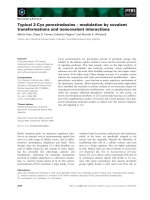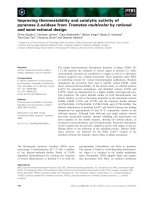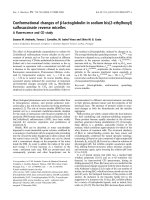2.0based businesses Uber, Amazon, Netflix, Airbnb, and Tesla
Bạn đang xem bản rút gọn của tài liệu. Xem và tải ngay bản đầy đủ của tài liệu tại đây (57.54 KB, 9 trang )
INTRODUCTION
According to Sia (2009), Web 2.0 is a new Internet method to promote information
exchange and cooperation among people on the network through web applications, and its model is
user-centred. Typical web 2.0 sites are online communities, applications, social networking sites,
and blogs. Web 2.0 allows users to interact and collaborate through dialogue on social media as
content creators in a virtual community. This method contrasts the first generation of Web 1.0 sites,
where people were limited to passively viewing content.
The advantages that global firms gain are advancements that online platforms have
attempted to aid in reducing business costs and increasing efficiency, whether through marketing,
production, or any other department of the company.
This evaluation will cover the background and information of five web 2.0-based
businesses and global marketspace theories applied to them, including Uber, Amazon, Netflix,
Airbnb, and Tesla. Usable strategies are required to succeed in the global market, as the essay will
outline the approaches that could be applied in Web 2.0-based businesses.
1
KEY ASPECT OF EACH BUSINESS
1) Uber’s Business Model
Uber is an American multinational company that provides transportation services through a
technology application. The company is headquartered in San Francisco, California. As of 2019,
the Uber service is available in 63 countries and over 785 metropolitan areas worldwide (Zhao
Xingyue & SU Qin 2020). The company's 2021 business results show that it has reaped large
profits thanks to a 56.7% increase in revenue from 2020 to $17.455 billion as demand for its
services rebounded strongly after the latest wave of the COVID-19 epidemic.
Uber connects drivers and passengers at scale using a smartphone app to receive ride
requests from passengers and then sends requests to drivers registered with Uber. In this case,
customers can know vehicle information, driver information, trip fare, location and travel route of
the nearest driver to receive the request. Uber works with four different business models.
Passengers must install the Uber app on their smartphones and use the available Uber apps to find
the closest car to pick them up. They can select a charge fare based on the type of car they want to
ride in, such as Economy, Premium, or Extra Seat. Carpooling with friends in an economy-class
sedan or medium-sized car is available. Premium class provides a luxurious car ride for passengers,
whereas Extra seats typically provide 6-7 seater rides in an SUV or MPV vehicle.
Having several ride-share options eliminates inconvenience (Banerjee, Riquelme & Johari
2015). Uber sets ride fares and payments for the passengers, which are charged for different
conditions based on peak or off-peak hours, distance and car type. Payment options include cash
and online credit card payments through the Uber app and associated online payment services.
Uber improves dependability and eliminates customer wait times, and it can provide a 20% to 30%
discount on taxi prices (Sun 2022). The e-hailing application is designed in such a way that it is
user-friendly. Instead of wasting time looking for taxis, Uber has made it simple for users to update
their software on mobile devices they own and hail electronically based solely on where they are in
the town and have it arrive in minutes
2) Amazon’s Business Model
Amazon is the world leader in online retail, rising strongly as a cloud computing service
provider. Amazon's starting point is a book-selling site, then expanded with a range of consumer
goods and digital media as well as Amazon's own electronic devices, such as Kindle e-book readers
and Kindle Fire, to become an e-commerce platform. Here all items from sellers worldwide are
listed under specific categories. Because of the complex algorithms and rich shopping environment
that Amazon brings, consumers gradually change their buying habits. Amazon's total consolidated
net sales revenue in 2021 was 469.82 billion US dollars, with international revenue channels
accounting for 127.78 billion US dollars (Mack 2022).
2
Amazon has invested in building a world-class delivery network that meets customers'
needs. Capture customer psychology when buying online: fast and free; Amazon has tried to do
this by building hundreds of warehouses across the US and other countries with ultra-modern
shipping systems. The processing process in Amazon's warehouse is applied according to the CFN
(Customer Fulfillment Networking) strategic model by Gallino. With this model, warehouse
productivity increased by 40%, and operating costs in 3 years decreased from 20% of revenue to
less than 10% of revenue. Recently, Amazon tested automated delivery based on a team of robots
with the first orders in Washington, which is considered the next step after the unfinished ambition
of Amazon's drone delivery.
Customers are the ones who bring profits, not competitors (Margerison 1993).
Understanding this, Amazon is constantly upgrading its shopping website platform. As a result,
consumers' shopping process becomes more accessible and convenient. Jeff Bezos consistently
asks thousands of Amazon executives to attend a two-day telemedicine course to help managers
understand that "Amazon's philosophy is to listen and understand customers".
3) Netflix Business Model
According to Giant (2022), Netflix is an American online video service, and the content is
mainly movies and TV shows, viral in the US and many other countries around the world. It offers
a variety of TV shows, movies, award-winning documentaries and more on thousands of Internetconnected devices.
In the year 2021, Netflix generated $29,698 billion in revenue. Netflix employs the Passive
trial theory, which states that people are more likely to feel grateful and want to compensate the
service provider after receiving a free service (Cranshaw 1995). This is a significant advantage of
Netflix over other video streaming services as they are willing to let users use the service for free
for the first month, after which customers can cancel at any time without incurring additional
charges.
Based on the theory of deep analysis of user behaviour of Kujala1 2008 in 2008, Netflix's
engineering team built a system called Netflix cookies. This system helps Netflix make movie
recommendations that suit users' tastes, saving them time and finding movies that match their
preferences. This platform owns a massive treasure of high-quality videos and movies such as
blockbusters, movies or TV series, sitcoms, animations, and documentaries. Additionally, Netflix's
movie download speed in all regions of the world is breakneck and stable compared to other movie
forums.
Customers of Netflix must pay monthly fees when they become subscribers to watch any
movie series in the Netflix library (Corbyn 2022). There are three subscription plans: basic,
standard, and premium, with monthly fees ranging from $9.99 to $19.99. Netflix employs another
3
"Social Network Analysis" theory by Alhajj & Memon (2011). This theory utilizes the network to
connect with customers ensuring that no matter what type of subscription plan customers choose,
all subscribers can watch the same thing in varying quality.
4) Airbnb’s Business Model
Airbnb stands for AirBed and Breakfast - a start-up with a business model that connects
people who need to rent and book rooms with people who have rooms to rent around the world
through a mobile application. All payments are made through the Airbnb app using a credit card,
and the broker charges a fee to both the person making the reservation and the host.
Airbnb has used the STU theory of Stu Borman. This theory states that redundant services
can provide passive financing. Airbnb brings in revenue for households with empty, rarely used
rooms. Sign up for Airbnb, both customers and tenants can rate each other after each use, so if the
host serves well and the guests are satisfied, they will leave positive feedback on the system and
attract the attention and choice of many other customers. Conversely, if customers stay on Airbnb
but are not polite to the host, they may refuse to rent the room. The fee for the host is 3% of the
total booking value, the booking fee is 6 - 12%, and this fee will be displayed during the guest is
using the service. This fee still ensures lower payers who book hotel rooms through traditional
channels.
Based on the theory of comparative advantage, opportunity cost is introduced as a factor to
consider when deciding between different production options (Matsuoka & Kikuchi 2012). More
and more people choose to book a room instead of staying at a hotel with advantages such as
cheaper room rates but still excellent service quality. Airbnb makes it possible for many people to
travel cheaply and brings unique experiences of the local life and culture.
5) Tesla’s business model
Tesla is an American company that designs, manufactures, and distributes electric vehicles
and components for electric vehicles. Unlike other automakers, Tesla does not sell products
through retailers but directly to consumers. The company has created an international network of
showrooms owned mainly by the company in urban centres. Using the theory of Kittler called
"Information channel", Tesla believes it can control the pace of its product development. More
importantly, the company can provide a better shopping experience for customers. Unlike car
dealerships, Tesla showrooms have no potential conflicts of interest, and customers only deal with
salespeople and the service provided by Tesla.
Tesla's strategy is to provide consumers with electrical products and enter the car market
with high-end vehicles aimed at affluent buyers. The company will enter the market with more
competition when the product is gradually perfected and sold well. This is similar to Su's "Inverted
4
Funnel" theory proposed in 2017, the theory that providing services and information to the
economic class will make those products and services become a trend of the less wealthy.
Targeting high-end products for wealthy leaders is a standard business strategy in Silicon Valley
and the global tech industry, where the prices of early versions of tech gadgets were all very high
initially and gradually decreased in later product processes.
Tesla's primary business model is comprised of three components: service, selling, and
charging network. Tesla uses direct sales, whereas other car companies only sell through franchised
showrooms. Tesla believes that utilizing a one-of-a-kind sales channel has gained a competitive
edge in terms of product development speed. They provide services through many sales service
centres with a dense network of supercharger stations where customers can charge their Tesla
vehicles for free for 30 minutes.
5 KEY STRATEGIES THAT COULD APPLY TO WEB 2.0-BASED BUSINESS
Based on Palmer, Simmons & Mason's article in 2013, this study proposes five key
marketing strategies for Web 2.0-based businesses. The first strategy is about using social media
effectively. Most businesses appear on the Internet, so having a website helps potential customers
review businesses, available products and services. Without appearing on social networks, it will
be hard for new enterprises to compete regardless of the quality and reliability of products and
services. For example, Facebook, Tiktok, Instagram, and WeChat are social media channels that
start-ups must understand to use to penetrate the market effectively.
The second strategy is to prioritize audience preferences. Companies are more likely to
meet customers interested in goods and services using this strategy. It also helps to shift
prospective customers down the ultimate gradient by reducing the likelihood of wasting ads on
uninterested eyeballs (Rubenson 2018). This will result in cost savings and, eventually, new
customers.
The third strategy is the use of technical development. This strategy will ensure that the
software meets the company's expectations and adheres to its objectives. Computer programs can
assist organizations in carrying out their tasks effectively and producing the expected results with
fewer human resources (Brent 2006).
The fourth strategy is to promote training. Employees trained in a firm are critical to the
company's success. Training not only improves employee performance and thus productivity and
profits but also boosts employee morale, leading to higher productivity and lower turnover.
The final category is applying marketing strategies. The primary advantage of
implementing marketing strategies is reaching specific, cost-effective, measurable audiences. Other
5
advantages of proper marketing strategies include increased brand recognition and international
expansion to broaden the consumer base.
6
CONCLUSION
Finally, this evaluation has gone through five Web 2.0-based businesses using various
global marketspace principles to develop winning strategies and use web 2.0 platforms to promote
and manage their businesses. The study also suggests some strategies for new businesses, such as
using social networks, prioritizing audience preferences, and implementing development, training,
and marketing strategies.
Word Count: 2039 words
7
List of References:
Alhajj, R & Memon, N 2011, "Introduction to the second issue of Social Network Analysis
and Mining journal: scientific computing for social network analysis and dynamicity", Social
Network Analysis and Mining, vol. 1, no. 2, pp. 73-74.
Banerjee, S, Riquelme, C & Johari, R 2015, "Pricing in Ride-Share Platforms: A
Queueing-Theoretic Approach", SSRN Electronic Journal.
Brent, M 2006, "To use or not to use? Shakespeare in management development?",
Development and Learning in Organizations: An International Journal, vol. 20, no. 3.
Corbyn, S 2022, Netflix price in 2022: How much you pay and what you get, viewed 14
October, 2022, < />Cranshaw, W 1995, "Onion Thrips Control Trial, FT. Collins, Co, 1990", Arthropod
Management Tests, vol. 20, no. 1, pp. 97-97.
Gallino, S, Moreno, A & Rooderkerk, R 2019, "Omnichannel Fulfillment Dilemmas:
Customer Preferences and Manager Perceptions", SSRN Electronic Journal.
Giant, N 2022, Netflix Statistics in 2022: The Status of the Internet Streaming Giant,
viewed 16 October, 2022, < />Kittler, W 2002, "The Dioskuroi: Masters of the Information Channel", Configurations,
vol. 10, no. 1, pp. 111-127.
Kujala1, S 2008, "Effective user involvement in product development by improving the
analysis of user needs", Behaviour & Information Technology, vol. 27, no. 6, pp. 457-473.
Mack, A 2022, The Business Model of Amazon, viewed 15 October, 2022,
< />Margerison, C 1993, "LEARNING FROM COLLEAGUES, CUSTOMERS AND
COMPETITORS", Management Development Review, vol. 6, no. 1.
Matsuoka, Y & Kikuchi, T 2012, "Footloose Capital and Comparative Advantage", Pacific
Economic Review, vol. 17, no. 5, pp. 677-686.
Palmer, M, Simmons, G & Mason, K 2013, "Web-based social movements contesting
marketing strategy: The mobilization of multiple actors and rhetorical strategies", Journal of
Marketing Management, vol. 30, no. 3-4, pp. 383-408.
Rubenson, D 2018, "Prioritize the needs of the audience when giving a presentation",
Nature.
8
Sia, Lim, Leung, Lee, Huang & Benbasat 2009, "Web Strategies to Promote Internet
Shopping: Is Cultural-Customization Needed?", MIS Quarterly, vol. 33, no. 3, p. 491.
STU BORMAN 2015, "Redox Protein Has Great Potential", Chemical & Engineering
News Archive, vol. 93, no. 48, p. 11.
Su, H & Wu, C 2017, "Funnel testing in webpage optimization: representation, design and
analysis", Statistical Theory and Related Fields, vol. 1, no. 1, pp. 3-14.
Sun, L 2022, Uber Technologies Stock: Bear vs. Bull | The Motley Fool, viewed 16
October,
2022,
< />
bull/>.
ZHAO Xingyue & SU Qin 2020, "Existing Issues of Ride Sharing Company Operation and
Sharing Economy in China: Uber Case Analysis", Management Studies, vol. 8, no. 1.
9









